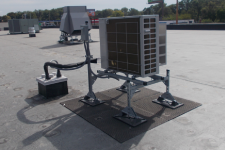jandlo
Structural
- Feb 28, 2006
- 33
In the midwest, we typically do this for small roof top mechanical equipment. Anchoring through the roof results in penetrations that are prone to leaks and require more frequent maintenance. I've never heard of one moving problematically let alone blowing off the roof or tipping over. Yet an overturning calc using the wind loads provisions of ASCE 7-10 (Rooftop Structures And Equipment For Buildings...29.5.1) suggest this thing should tip over in a typical heavy wind. A 400 lb wind load on the face of a 200lb unit+stand in this configuration shouldn't work.
Is the code ridiculously conservative? Am I overlooking something?
I don't really want to get into theory, but I've had discussions about rooftop pavers and why they don't fly away even though the uplift calcs show they should. Could it be that these forces are for gusts of wind, if attached rigidly, might transfer to the structure, but because it's not, the force is dissipated by infinitesimal rotation of the object? Grasping at straws here. It's frustrating because I always get questioned about my designs and have the code required calcs to back it up, but clients and contractors point to hundreds of real life examples contradicting it. Hard to argue.

Is the code ridiculously conservative? Am I overlooking something?
I don't really want to get into theory, but I've had discussions about rooftop pavers and why they don't fly away even though the uplift calcs show they should. Could it be that these forces are for gusts of wind, if attached rigidly, might transfer to the structure, but because it's not, the force is dissipated by infinitesimal rotation of the object? Grasping at straws here. It's frustrating because I always get questioned about my designs and have the code required calcs to back it up, but clients and contractors point to hundreds of real life examples contradicting it. Hard to argue.

